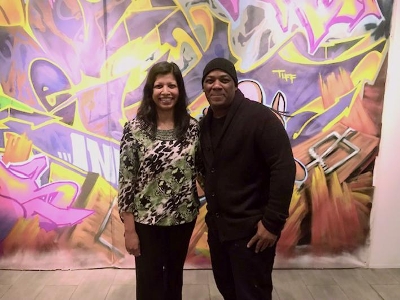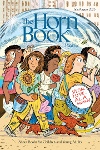Profile of 2023 CSK Illustrator Award winner Frank Morrison
Every time I speak with Frank Morrison, I learn a cool fact about him. For instance, during one conversation, he told me that when he was a child, his favorite pastime was drawing Quicky, the official Nestle’s Nesquik mascot. What would he draw on? Fancy sketchpads? Reams of construction paper? Nope! Frank would draw on the pieces of white and tan cardboard that came with his mother’s L’eggs egg-shaped pantyhose containers. I find this tidbit not only endearing but also quite telling.

Sonali Fry and Frank Morrison. Photo courtesy of Sonali Fry.
Every time I speak with Frank Morrison, I learn a cool fact about him. For instance, during one conversation, he told me that when he was a child, his favorite pastime was drawing Quicky, the official Nestle’s Nesquik mascot. What would he draw on? Fancy sketchpads? Reams of construction paper? Nope! Frank would draw on the pieces of white and tan cardboard that came with his mother’s L’eggs egg-shaped pantyhose containers. I find this tidbit not only endearing but also quite telling. Frank’s goal was to draw, and he found ways to make that happen. This one example speaks to the grit and determination he has demonstrated throughout his life so that he could follow his dreams, make a difference, and inspire others.
I first met Frank at an ALA conference in 2015. I was working at Little Bee Books at the time, and when I saw him signing Little Melba and Her Big Trombone (written by Katheryn Russell-Brown) at Lee & Low’s booth, I went over and introduced myself. I didn’t have a project in hand for him at the time, but I gave Frank some background information about Little Bee Books and told him that I hoped he would consider working with us someday.
Several months later, I had the perfect manuscript for him to illustrate: The Roots of Rap: 16 Bars on the 4 Pillars of Hip-Hop, written by Carole Boston Weatherford. The fabulous text was a love letter to the pioneers of hip-hop, and Frank was immediately taken with the manuscript because 1) Carole, with whom he adored working, had written it; and 2) Frank grew up with this culture.
The first time Frank heard rap music was in his grandmother’s backyard, via a one-speaker radio. “It was Run-DMC, Sucker M.C.’s, and then Planet Rock.” Frank said that “the beats were phenomenal,” and he and his brother “were paralyzed by the music.” Up to this point they had been listening to what their parents listened to, because they didn’t know there were other options. They found familiar beats in hip-hop because it felt like a remix of their parents’ music.
Hip-hop opened up a whole new world for Frank. In the Bronx in the eighties, “destruction was all around. There was a wall left over from a demolished building. They had a whole world created around us that was counterculture to what was happening in our parents’ world. Hip-hop accepted us. You found how you fit in,” he said. Frank still listens to hip-hop while he’s working and likens it to wine. He doesn’t like the current flavors as much, but he savors the “vintage” hip-hop, like Nas from 1990. “It has an oaky flavor to it, but it’s great!”
Many of Frank’s books feature his signature graffiti artwork. When he was living in New Jersey in the late eighties, Frank started drawing on walls in parks. He hung out with a group of friends who taught him how to create graffiti. They would go to New York and be inspired by the urban hieroglyphs of downtown Manhattan. Seeing these elaborate works pushed Frank to improve his own work. He practiced painting every day and refined his technique. In the nineties, when he was selling his fine art, he was encouraged by Bruce Teleky, an art distributor, to paint his community as it was at the time. Frank started painting detailed scenes and landscapes using his graffiti style. For The Roots of Rap, he used this style to portray the founders of hip-hop. Frank’s electrifying paintings captivate us as we get an introduction to the essence of rap. He poured so much of himself into this book, and the energy in each piece vibrates off the page. Frank says that even today, he’s constantly practicing his graffiti skills and learning new techniques. He loves writing with graffiti crews and “will do walls for exercise!”
* * *
I saw Frank again in October 2019 at The Original Art exhibit of the Society of Illustrators, after I had started working at Random House. Frank told me he was hoping to take on fewer book projects so he could focus on his fine art. This worried me because I had been editing Carole Boston Weatherford’s reworked lyrics for “Standing in the Need of Prayer,” and I really wanted Frank to illustrate this book. I was able to talk with him for a few minutes about the text, and I saw his excitement grow. Frank appreciates that Carole “is capturing unsung stories that we need to know.” To my delight, he accepted this project.
 Standing in the Need of Prayer: A Modern Retelling of the Classic Spiritual chronicles the milestones, tragedies, and triumphs of African American history. It details a past that is painful, and illustrating this kind of subject matter in a picture book can be tricky. However, Frank wasn’t afraid to embrace this head-on. I remember him saying, “This is history. We can’t escape it or pretend it didn’t happen.” Frank interpreted the text himself and created the most emotive and sometimes heart-wrenching scenes. Every piece of art takes your breath away.
Standing in the Need of Prayer: A Modern Retelling of the Classic Spiritual chronicles the milestones, tragedies, and triumphs of African American history. It details a past that is painful, and illustrating this kind of subject matter in a picture book can be tricky. However, Frank wasn’t afraid to embrace this head-on. I remember him saying, “This is history. We can’t escape it or pretend it didn’t happen.” Frank interpreted the text himself and created the most emotive and sometimes heart-wrenching scenes. Every piece of art takes your breath away.
As soon as we open the book, we see the front endpapers depicting a harrowing scene of an enslaved boy about to experience brutality. Later on, we see a stone being thrown at Ruby Bridges. This illustration has a unique angle and perspective. We see Ruby’s defiance in her face, even with the crowd’s anger and insults. Frank angled Ruby so that she’s almost at a diagonal to the page. It’s as if she’s rising above the hate, which is what she and so many others had to do in order to survive. On the back cover, we see an illustration of a present-day Black girl leaning against a sign that says, “MY LIFE STILL MATTERS.” This girl knows she has a purpose and that she deserves to be heard. There’s a stark contrast between the enslaved child at the beginning of the book and this child at the end who is free to live her life as she chooses. Frank did this to put a hopeful spin on the book — things can get better: Truth. Pain. Hope.
The cover was the last part to be created. Frank submitted several sketches, and while they were beautiful, they weren’t quite right…yet. This was a challenge: how do you capture the essence of such a dynamic book in one image? In the end, art director Nicole de las Heras and I got on a Zoom call with Frank, and he sketched as we brainstormed ideas. It was captivating to watch Frank work, and to see him lay the foundation for this stunning cover in real time.
This past January, Frank’s magnificent work on Standing in the Need of Prayer was recognized when he won the Coretta Scott King Illustrator Award. So many people told me that they had tears in their eyes when the book appeared onscreen during the ALA awards presentation. This cover stops you in your tracks; it’s that powerful, and it’s impossible to not be moved when you see it.
Looking through Frank’s books is like walking through an art gallery. He can transport you to another time or put you in the middle of a cultural movement, while making the connection between past and present. He teaches us about American history — the parts we’re proud of, and the parts we can’t deny. His illustrations stop readers and make them pause on each page, absorbing the emotion. This is what he’s accomplished with Standing in the Need of Prayer, and this is what he’ll continue to do with every gorgeous piece of work he creates. I can’t wait to see how he’ll wow us next.
From the July/August 2023 issue of The Horn Book Magazine: Special Issue: ALA Awards. For more speeches, profiles, and articles, click the tag ALA 2023.
 Single copies of this special issue are available for $15.00 including postage and may be ordered from:
Single copies of this special issue are available for $15.00 including postage and may be ordered from:
Horn Book Magazine Customer Service
magazinesupport@mediasourceinc.com
Full subscription information is here.

RELATED
ALREADY A SUBSCRIBER? LOG IN
We are currently offering this content for free. Sign up now to activate your personal profile, where you can save articles for future viewing.







Add Comment :-
Be the first reader to comment.
Comment Policy:
Comment should not be empty !!!